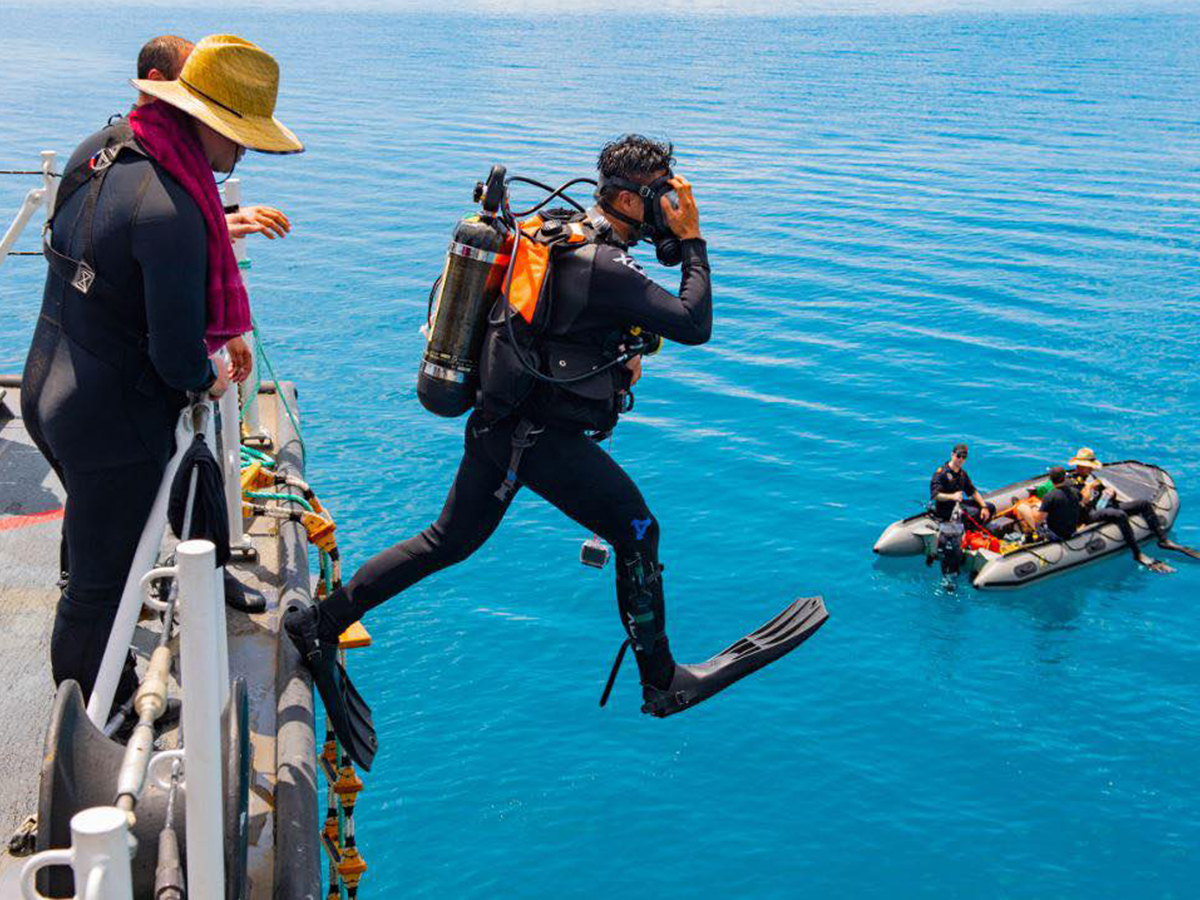Diving Officer reveals what it takes to keep a deployed ship top-notch
By Lookout Production on Oct 17, 2022 with Comments 0
Kateryna Bandura,
Lookout Editor
—
HMCS Vancouver’s Dive Team is making true the old adage, one person’s trash is another person’s treasure.
“Some of the fishing lines we have found tangled on our blades and propellers were cut and we are making them into bracelets,” said Sub-Lieutenant (SLt) Ryan Gan, Vancouver’s Dive Officer.
Free-floating fishing nets can be very difficult to spot, and if run over, could potentially damage a ships’ propellers, yet Vancouver’s Dive Team found a use for the pesky hazard, which is surprisingly a fairly frequent occurrence when operating on the high seas.
The Dive Team collects such souvenirs, if found, during routine maintenance and hull inspections every time the ship gets into a port. Currently, HMCS Vancouver is deployed in the Indo-Pacific on Operation Neon, Canada’s contribution to enforcement of U.N. Security Council (UNSC) sanctions on North Korea.
SLt Gan said routine maintenance and hull inspection is no easy task.
“With anything involving diving, underwater is always a hazard to our divers,” SLt Gan said. “Dangers include equipment failure, getting caught when under the ship, or something turning on when it should be off.”
The team meets with the ship’s Marine Systems Engineering and Combat Systems Engineering departments before every dive to ensure divers’ safety. An announcement broadcast throughout the ship every 15 minutes reminds the ship’s company of activity under water, and Flag Alpha, a white and blue flag, signal to other ships visually that there are divers underneath.
“If other ships are nearby, such as in foreign ports, as the Diving Officer I would go over to the other ship with my senior diver and a translator (if required) to ensure everyone is on the same page with what is going on,” SLt Gan said.
The inspection takes about an hour, he said. Since the diving evolutions only require divers, the rest of the ship goes about their regular tasks and jobs.
Routine maintenance and hull inspection have a few steps, SLt Gan said.
The divers look at the wear and tear of the shafts that propel the ship, and inspect the blades and rotating mechanism for excess damage and chipping. To check the wear of the turning shaft, they use a ‘poker gauge,’ which measures how much the shaft has worn down due to the spinning motion. They also inspect the rudder.
“We look for things like indications of damage or chips,” SLt Gan said. “These are filmed and brought to Marine System Engineers for their records and further action.”
The divers also inspect suction grates throughout the ship’s hull – these suck in water to provide cooling to the machinery onboard. When ships drive through congested waters and busy ports, these grates can get clogged by garbage, lines, and marine growth. The divers remove the garbage and bring it up for disposal.
While some maintenance is as easy as removing nets with a knife, other requires specialized equipment, such as when maintaining the ship’s sonar dome.
The sonar dome is a large bathtub piece in front of the ship, which protects a sonar system. Due to its location, constant water running past the dome sometimes loosens the bolts, which can interfere with the ship’s Sonar Operators’ job.
“We need to ensure the bolts that hold the prongs along the dome’s top lip are tight so they do not cause excess noise and allow the ship’s operators to use the sonar efficiently,” SLt Gan explained.
Typically, it takes a minimum of two divers to complete the inspection. SLt Gan said he often tries to incorporate as many non-divers from the ship’s company as possible to expose them to what they do and possibly recruit new divers.
“The more divers we have, the more we can achieve and the faster the jobs can get done,” he said. “Become a Navy Diver, it’s cool and fun!”
Any trade on ship can apply to join the ship’s dive team as a secondary duty. For information on how to become a Ship’s Team Diver visit Fleet Diving Unit (Pacific)’s webpage and click on ‘How to Become a Diver’: esquimalt.mil.ca/fdu/Training/howtobeSTD.htm
Filed Under: Top Stories
About the Author:







